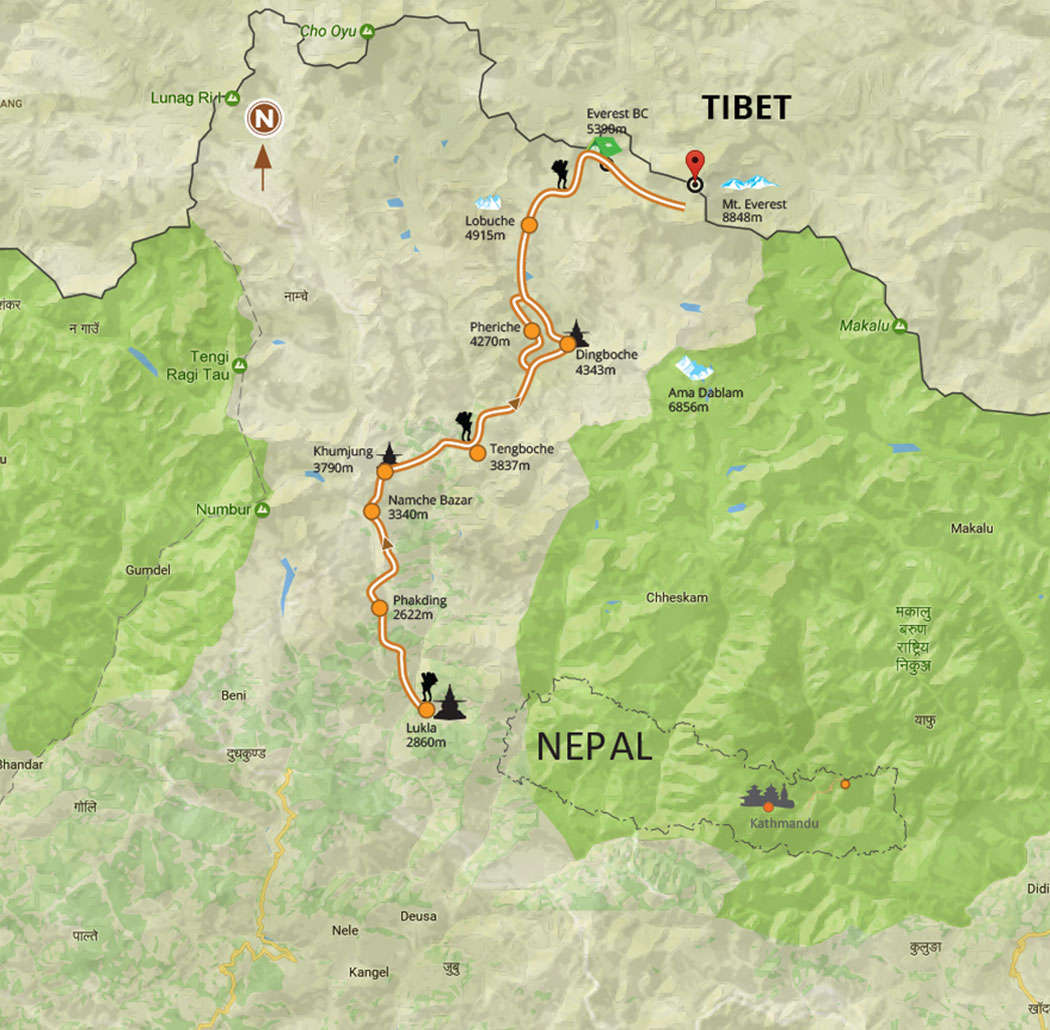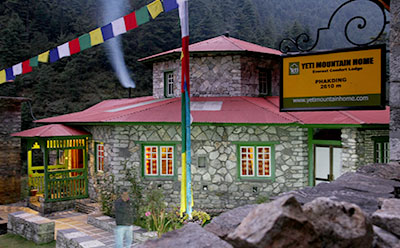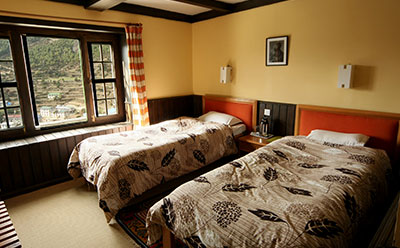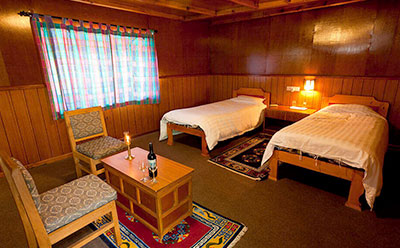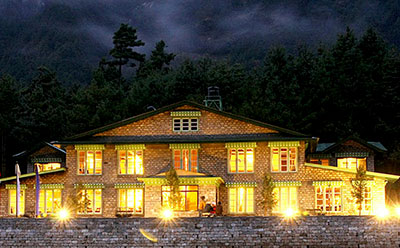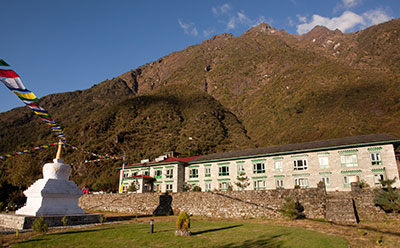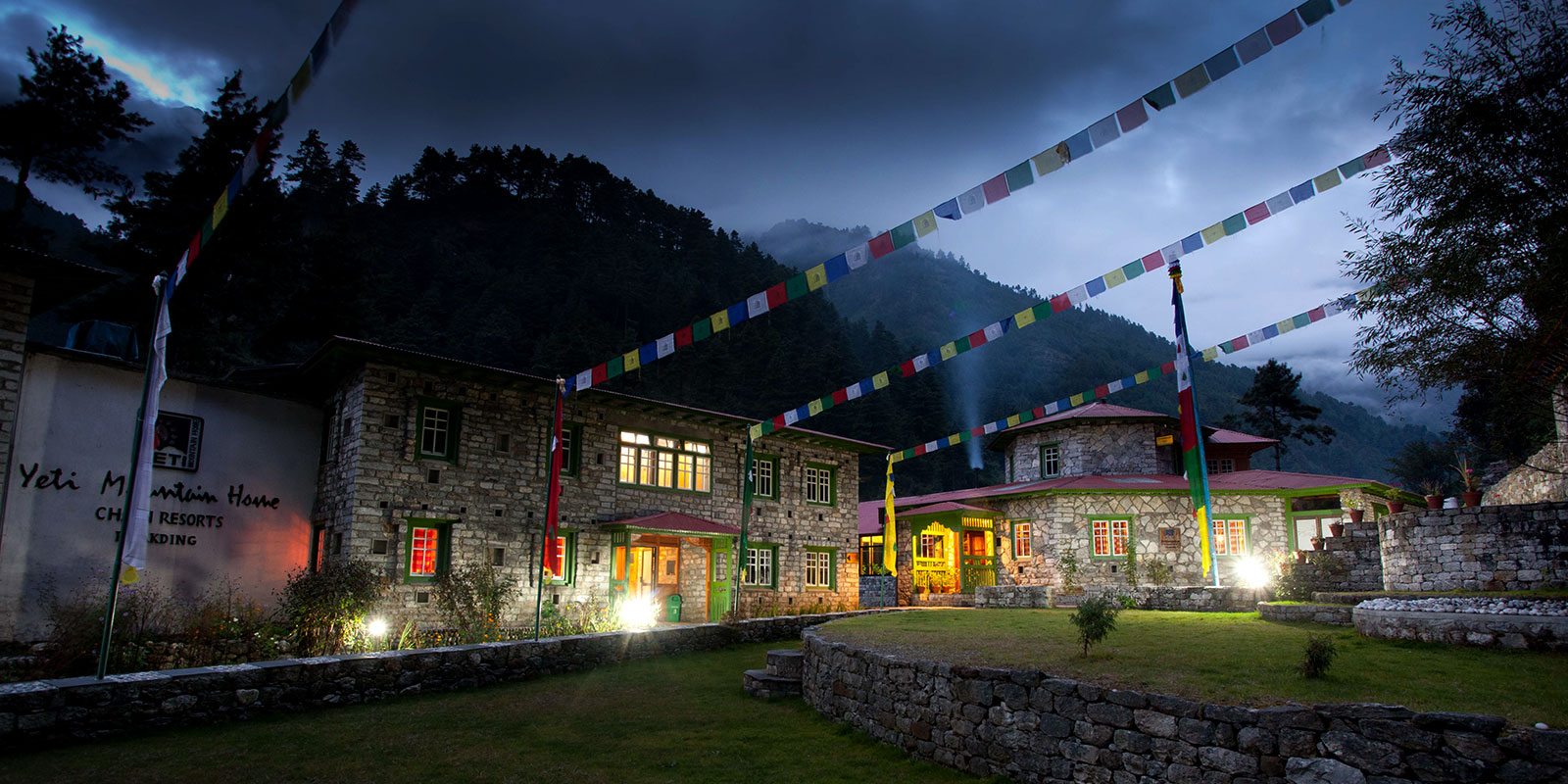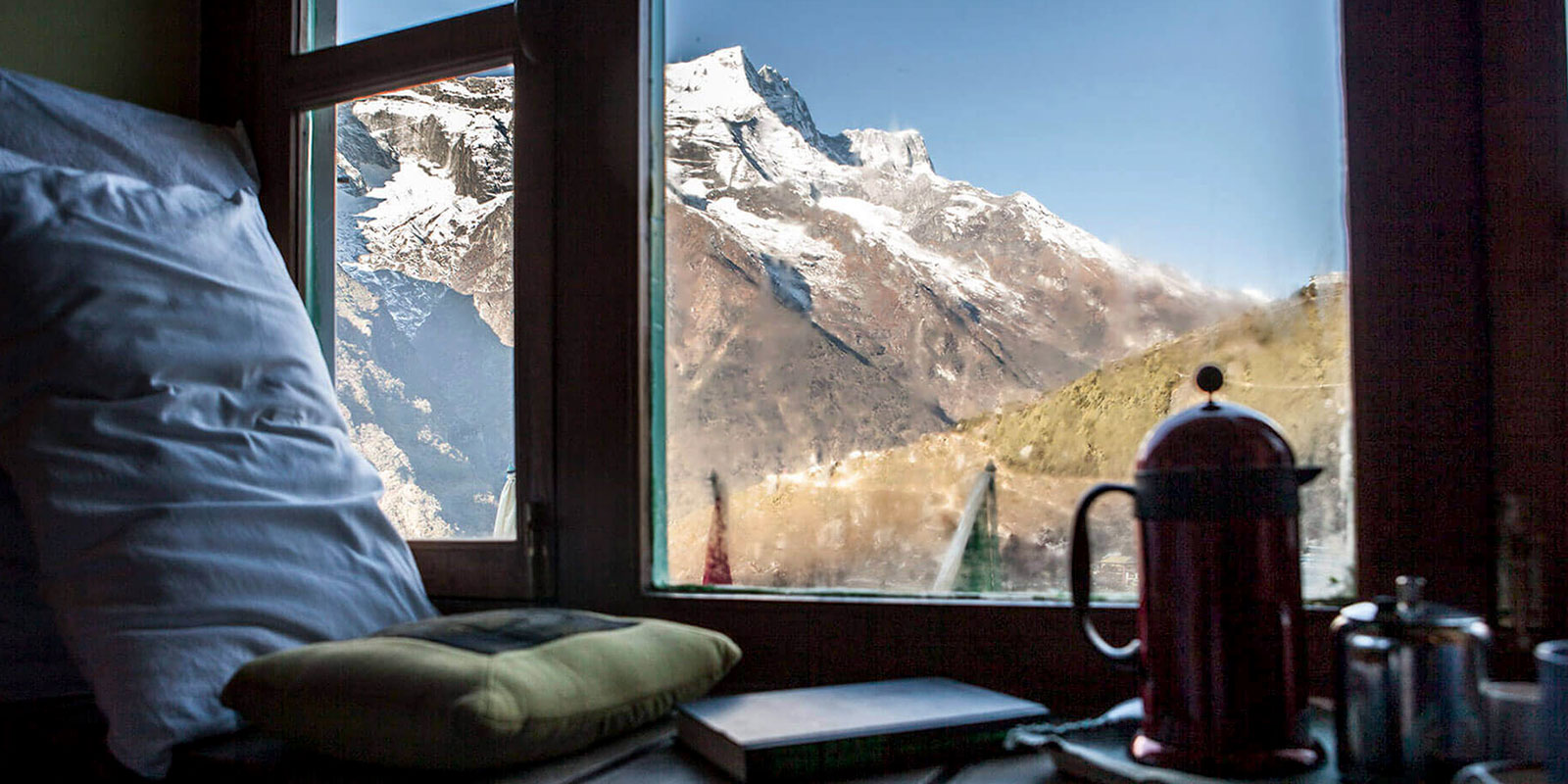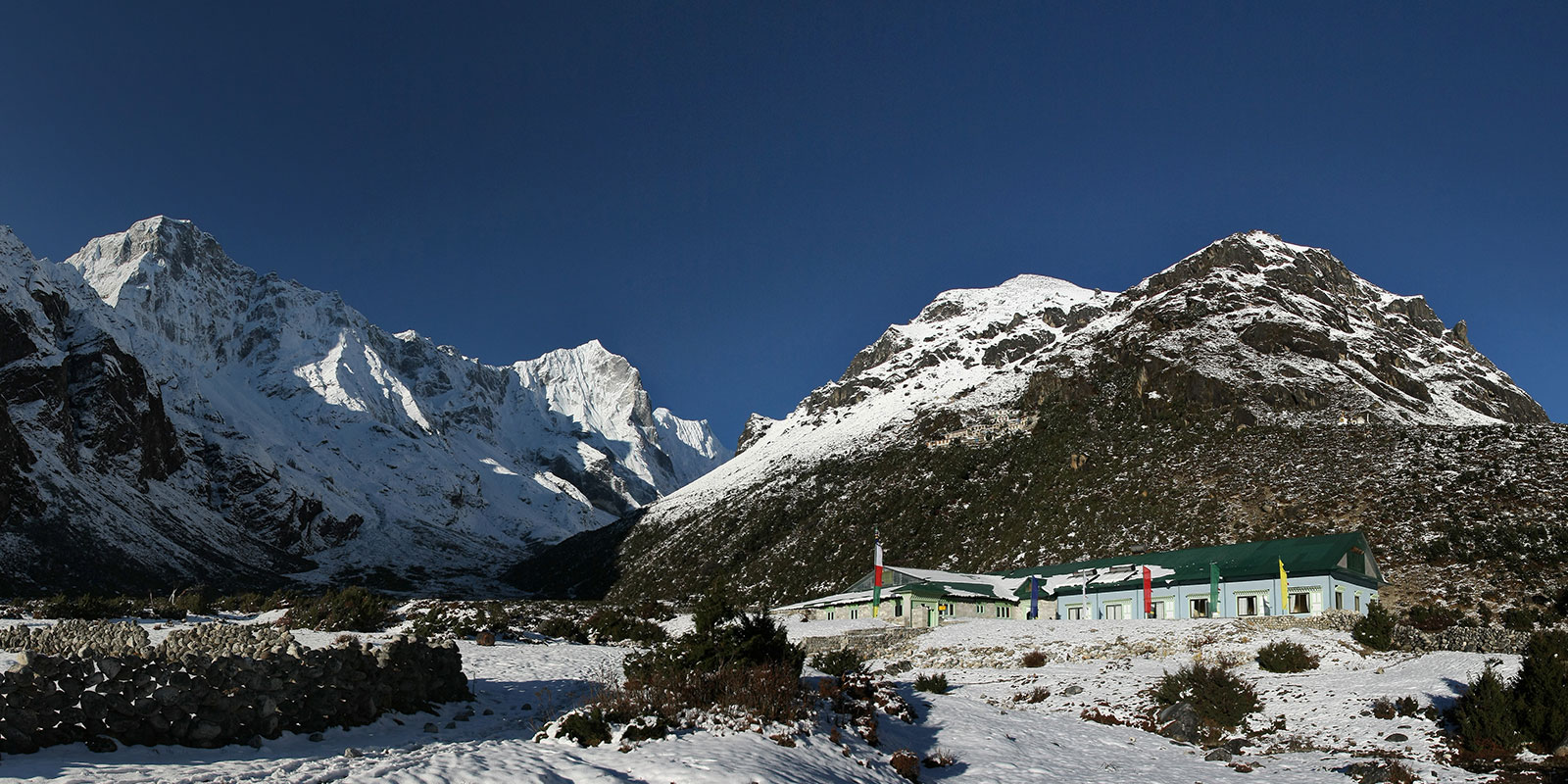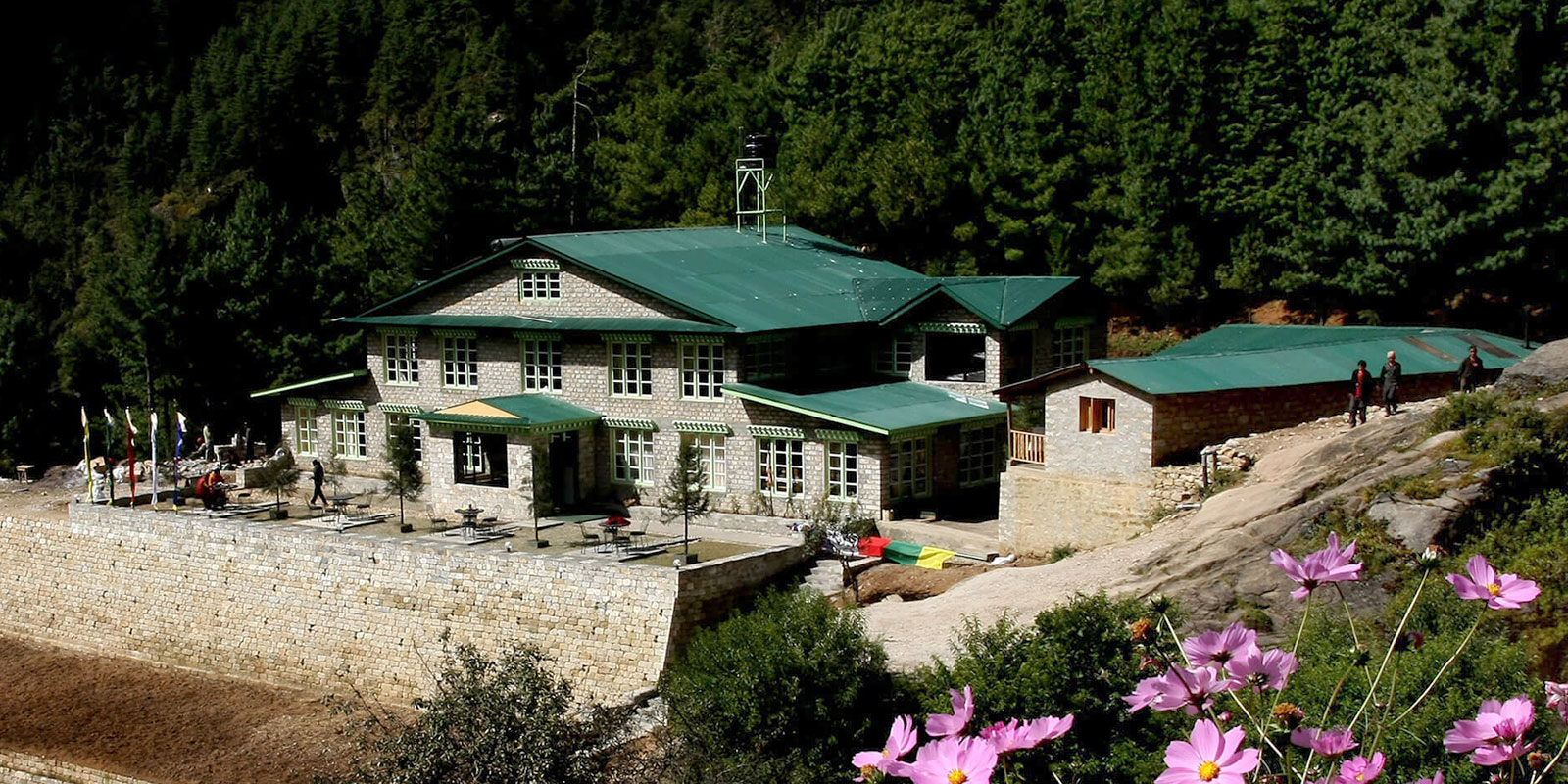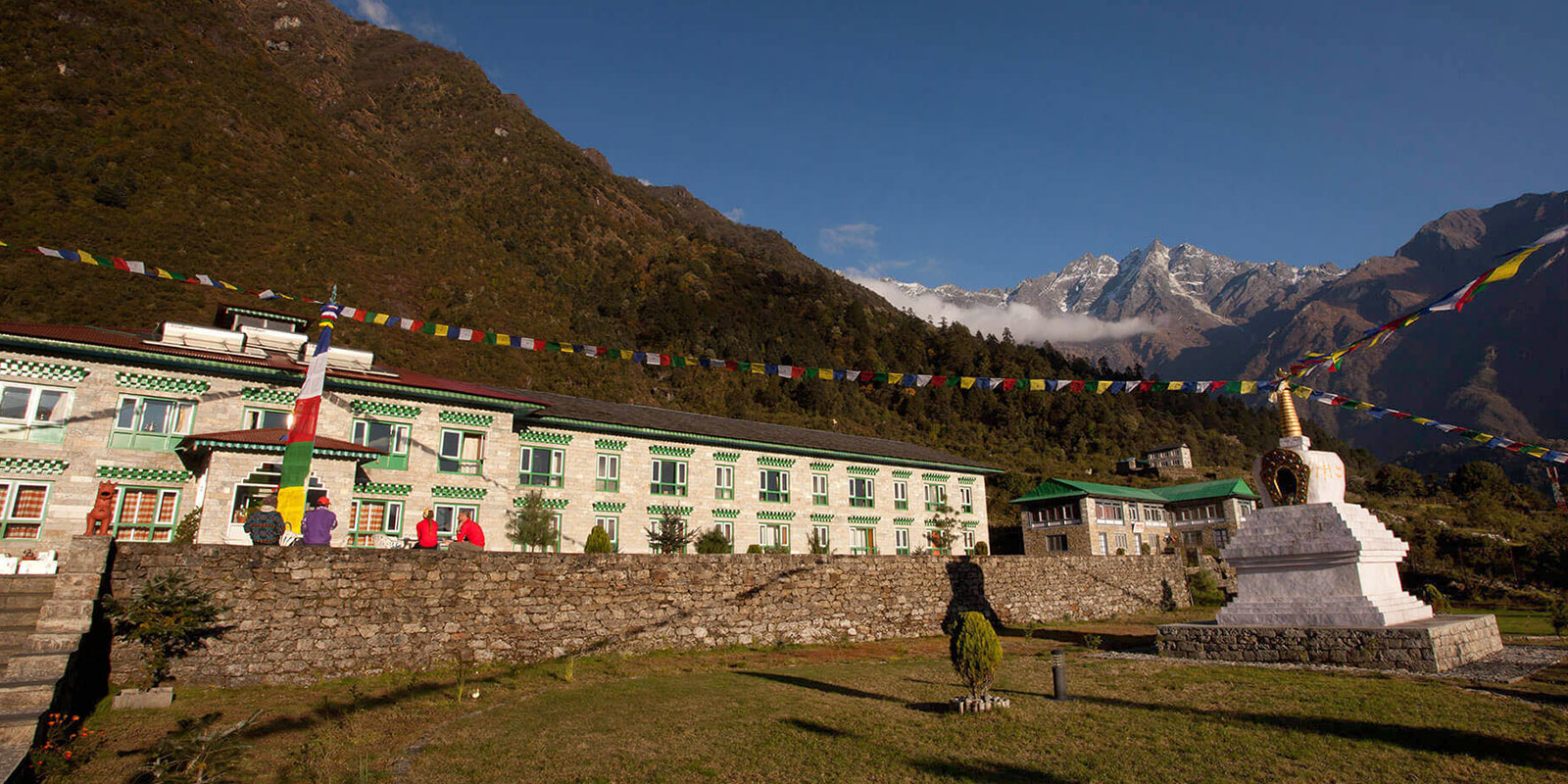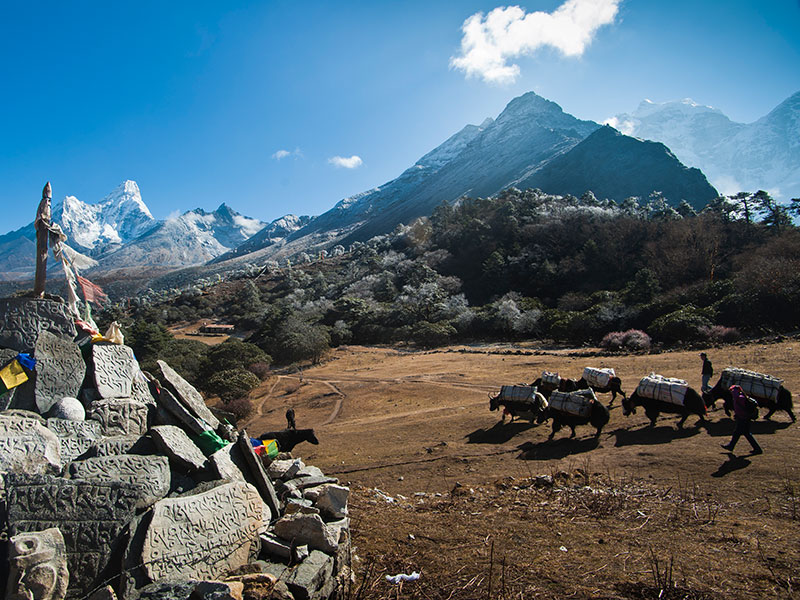
Everest Three Passes Trek

Everest Three Passes Trek
-
Destination:Nepal
-
Region:Everest
-
Type:Tour
-
Max. Altitude:5170m
-
Activity:Lodge Trek
-
Group size:12 people
-
Accomodation:Hotel, Lodge
-
Starting and ending in Kathmandu, this 18 nights / 19 day is also called the Ultimate Everest Experience taking you through the 3 strenuous passes in Everest including Renjo, Chola and Khongma La pass and taking you to Everest Base Camp and the famous Kalapattar.
Trip Highlights
- Enjoy your stay in our comfortable luxury lodges throughout the trek (optional).
- Experience the ultimate Everest Trek with 3 high passes Renjo La, Cho La pass and Khongma La pass
- Visit Everest Base Camp.
- Experience the Sherpa cultures and the Sherpa land with this.
What is included
- 3 nights in Kathmandu Hotel as per program on Bed & Breakfast basis
- 15 nights in local Lodge as per program on full board basis
- Flight: KTM-Lukla-KTM (Regular Flight) with airport taxes
- National Park Fees & TIMS Permit Fee
- 1 full day sightseeing in Kathmandu with english speaking tour guide
- 1 English Speaking Guide (from Kathmandu)
- 1 porter for every 2 members
- All staffs insurance & daily wages
- All Airport transfers
What is not included
- Lunch & Dinner in Kathmandu
- Personal Equipment & Insurance
- Personal Expenses (Battery recharge on local lodge, laundry, telephone, etc)
- Nepal Visa fee US $40 per person
- Emergency Evacuation if required
- Other personal Expenses
- Tips for Staffs
Contact Our Travel Specialist
Mobile: +977 9801236280
This email address is being protected from spambots. You need JavaScript enabled to view it.Trip Notes
Download the detailed trip notes for everything you could possibly want to know about this trip, including detailed itinerary and full kit list.
View Trip NotesDifficulty Level

Moderate to Hard
Full-day hikes (4-6 hours), mountainous terrain, significant elevation gains and losses (hiking up or down as much as 3,000 feet) on many hikes. Altitudes no greater than about 10,000 feet.
-
Detailed Itinerary
-
Day 1
Arrival in Kathmandu
Meals: BDepending on your arrival time, our representative will be at the airport to receive you and transfer you to your booked hotel.Meals: B -
Day 2
Flight: Kathmandu – Lukla (2850m) - trek to Phakding (2610m) – 25 minutes flight / 3 hrs walk
Meals: BLDAccommodation: YMH PhakdingAfter breakfast in the hotel, we drive to the domestic terminal of Kathmandu Airport for the 30-minute flight to Lukla. Landing on the narrow, sloping runway high above the Dudh Koshi River in the heart of the mountains is a very spectacular way to arrive. We will be staying 2 nights in Namche Bazaar to acclimatise. After meeting our porters we will take lunch at the Yeti Mountain Home Lodge and then start our trek with an easy, mostly downhill leg, from Lukla to Phakding. This trek takes us through pastoral lands of the Sherpas and we pass several small villages and individual farms. Many Sherpas now make their living exclusively from trekking and there are also many tea houses and basic lodges where it's possible to stop for a drink or a chat. We will also pass by many stones intricately carved with prayers in the evocative Tibetan script, and prayer wheels of all sizes. Everywhere in the valley colourful strings of prayer flags flutter from high points and bridges. After 2-3 hours of trekking, we finally meet the river and reach our first lodge at Phakding located beside the tumbling Dudh Koshi. The altitude at this first stop is actually lower
than Lukla at 2610m.Meals: BLDAccommodation: YMH Phakding -
Day 3
Trek to Namche (3440m) – 5 hrs trek
Meals: BLDAccommodation: YMH NamcheAfter breakfast, we trek to the village of Monjo. The gently undulating trail follows the right bank of the Dudh Koshi through Phakding village before the first of several river crossings today on wire suspension bridges. Continuing through pine forest and small villages we come to a break in the trees to catch sight of the mighty Thamserku (6623m) towering way above. A couple more hours of woodland trails and swaying bridges brings us to the small village of Monjo.
We stop to have a look at the interesting 3D map and information boards whilst our guide sorts out our permits and entry. From here we’ve another 40 minutes or so along the sides of the Dudh Khosi before crossing the Bhote Khosi and beginning our climb to the Sherpa capital of Namche Bazaar. The trail zigzags up away from the river, gradually ascending to the tree line opening out
into a high mountain bowl and the vibrant village of Namche. We pass through the many tiny shops and colourful stalls picking our way slowly up hand cut stone steps to our wonderful Yeti Mountain Home Lodge. This is our first night above 3000m so it’s important to take it easy and let your body adjust. Relax with a tea or coffee and maybe even take a massage in our spa.Meals: BLDAccommodation: YMH Namche -
Day 4
Excursion day in Namche (3440m)
Meals: BLDAccommodation: YMH NamcheSituated at high altitude, Namche Bazaar serves as an acclimatization stop for climbers to avoid altitude sickness. Namche Bazaar is the main center of the Khumbu region and is facilitates with government offices, internet, ATM’s, restaurants and a colourful market. You can also take a half day excursion to the internationally known Museum of Sherpa Culture and the traditional villages of Khunde and Khumjung. The location of our lodge is superb giving us a bird’s eye view over Namche and across the Valley to the serrated ridges of the Kongde range, while the magnificent peak of Thamserku (6623m) rises as a backdrop. Just a short walk away is a classic view of Ama Dablam, one of the most beautiful mountains in all Nepal and of Lhotse and Everest. This is an ideal place to spend the day, acclimatising to the new altitude before heading further up-valley to Thame.Meals: BLDAccommodation: YMH Namche -
Day 5
Trek to Thame (3820m) – 5 hrs trek
Meals: BLDAccommodation: YMH ThameAfter breakfast at our lodge, we start the day with a 2 to 3-hour walk through the forest of spruce, juniper and pine to the village of Thame. This trail is much less used by trekkers and we will immediately notice the difference. It is, however, an important trail which leads all the way to Tibet via the Nangpa La on the shoulder of Cho Oyu (8012m). On today’s trek, we are likely to see few other trekkers. We stop for our lunch in Thame which is the home village of the Ang Rita Sherpa, who has summited Everest 10 times without oxygen. After lunch, we continue walking for another 2 hours to arrive at a deep gorge where the Bhote Koshi River thunders through the narrow defile. We cross a sturdy bridge spanning the gorge to reach Thame (3800m). This important village is the home of many famous mountaineers including Tensing Norgay the first man to reach the summit of Everest along with Sir Edmund Hillary. Apa Sherpa who has reached the summit at least 18 times lives here now. The village is very picturesque and also has a magnificent 16th-century Nyingmapa Gompa (monastery) built by Lama Rolwa Dorje. We check into our deluxe rooms with breathtaking views of Thamserku and Kusum Kanguru.Meals: BLDAccommodation: YMH Thame -
Day 6
Trek to Lungden (4610m)
Meals: BLDA strenuous walk to Lungden for about 4 hours will go through the stunning landscapes through the route that was used to trade for Tibetan taking us to the valley of. As you head into the wild country with few villages, you will meet few trekkers going along this way.Meals: BLD -
Day 7
Trek to Gokyo (4750m) – 4/5 hrs trek
Meals: BLDTrekking towards Pangka, you will take the trail that drop slightly to a large cave area known as Nilibuk. Climbing a steep rocky incline into the valley by side of the glacier and passing the holy lakes. Arriving second lake you cross the path leading to the glacier to Cho La that leads towards Lobuche. Dudh Pokhari is the 3rd lake you see as you head towards Gokyo walking by the side of the lake enjoying the panorama of Cho Oyu and Gyachung Kang.Meals: BLD -
Day 8
Trek to Dragnag (4700m) – 2/3 hrs trek
Meals: BLDAfter breakfast you continue your trek from Gokyo Lake with the ascending trail through up and down of the glacier reaching Dragnag also popularly known as the base camp of Cho La Pass where you will spend an overnight. With limited lodges and basic facilities, however the trip to Dragnag is a memorable one with its amazing view of the mountains.Meals: BLD -
Day 9
Trek to Dzongla via Cho la pass – 6/7 hrs trek
Meals: BLDA strenuous day today you will trek through vertical trails and the rocks glazed by ice. You have to be very careful today as the trail may be slippery. The rocky trails climbs through the narrow valley as you climb up towards Phedi. Trekking through the side of the frozen lake going to the top of Cho La pass that lies at the elevation of 5468m is a place with decorated prayer flags. After enjoying the views from here, you take the trail that descends steeply towards Dzongla (4830m) where you can see some basic tea house lodges scattered.Meals: BLD -
Day 10
Trek to Gorakshepe (5170m) – 4 hrs trek
Meals: BLDAs you trek up to Gorak Shepe leaving Dzongla. You walk further towards Lobuche through the trail that descends and ascends gradually until you reach Lobuche providing great views of Ama Dablam, Nuptse, Everest, Pumori and Lobuche peak.
You head out on narrow tracks that are at times a few feet wide and few hundred meters above the ground. You also walk through the wide valleys as well. You arrive at Gorakshepe with few lodges available. You check in and rest for your walk to Everest Base Camp tomorrow.Meals: BLD -
Day 11
Visit Everest Base Camp and back to Gorak shepe (5170m) – 5 hrs trek
Meals: BLDAn exciting day today as you visit the Everest Base Camp. As you walk across the rocks towards the many prayer flags that mark the spot, you will arrive at Everest Base Camp. During the expedition season, many of the groups are settled here in their respective camps awaiting their climb to the highest mountain in the world. You can even interact with some of them.
After taking photographs and enjoying the moment, we head back towards Gorakshepe.Meals: BLD -
Day 12
Hike upto Kalapatthar and trek back to Lobuche.
Meals: BLDAn early morning hike to Kala Patthar to view the sunrise along with Everest. We retrace our steps back to our lodge where we have our breakfast and continue our trek back to Lobuche.Meals: BLD -
Day 13
Trek to Chukkung via Kongma la pass (5528m): 7 hrs trek
Meals: BLDMany of the trekkers do not take this route to arrive in Chukkung giving it a super off trail experience mainly due to the strenuous nature. The trail goes uphill towards the southeast direction Khumbu glacier with a great view of Lobuche and Pumori along with the other surrounding mountains. Kala Patthar looks stunningly beautiful.
As you continue the sloping trail you can enjoy more and more panoramic views of Lobuche village along with other peaks.Meals: BLD -
Day 14
Trek to Tengboche (9870m) – 5 hrs trek
Meals: BLDThe trail goes down the valley, continuously passing picturesque mani walls and chortens. After a short descent, it meets the main trail, descends gradually then steeply to Phunki on the banks of the Dudh Koshi. From there it climbs steeply at first, then makes a gradual ascent through forests and around Mani stones as it follows the side of a hill up to the saddle on which Tengboche Monastery sits.Meals: BLD -
Day 15
Trek to Monjo (2835m) – 5 hrs trek
Meals: BLDAccommodation: YMH MonjoThe trek today takes you back to the same trail giving you great views of Everest, Nuptse, Lhotse and Ama Dablam as you descent down the Dudh Koshi River. After crossing the river, you take an uphill again till the balcony path taking you around to Namche. A long descent and you arrive at Monjo where you spend an overnight.Meals: BLDAccommodation: YMH Monjo -
Day 16
Trek to Lukla (2850m)
Meals: BLDAccommodation: YMH LuklaYour last day of the trek today on the trek will take you through the pine and rhododendron forests with few hours of a steady climb to Lukla.Meals: BLDAccommodation: YMH Lukla -
Day 17
Fly back to Kathmandu
Meals: BBidding goodbye to your porters and staff, you fly back to Kathmandu where our representative will be waiting for you to take you to the hotel where you can enjoy your chilled beer and warm shower.Meals: B -
Day 18
Full day sightseeing in Kathmandu
Meals: BAfter breakfast, you tour guide for today will meet you at the lobby for a full day sightseeing in Kathmandu – a culturally rich city with many touristic sites listed as heritage sites. You will be visiting Boudhanath, Swayambhunath, and Bhaktapur all of which are important heritage sites in Kathmandu.
These heritage sites were affected by the earthquake. Boudhanath Stupa, one of the biggest stupa in Nepal is fully restored and Swoyambhunath and Bhaktapur are undergoing the restoration process. Your experienced tour guide will share interesting facts and stories about these heritage sites.
After the sightseeing, you will be transferred back to the hotel.Meals: B -
Day 19
International departure
Depending on your flight time, you will be transferred from Hotel to the airport. The airport time is 3 hours prior to departure time and the hotel checkout time is 12:00 PM. In case you are flying late evening and require a half day use of the hotel, you can let us know in order to confirm the room for you.
Contact Our Travel Specialist
Mobile: +977 9801236280
This email address is being protected from spambots. You need JavaScript enabled to view it.Trip Notes
Download the detailed trip notes for everything you could possibly want to know about this trip, including detailed itinerary and full kit list.
View Trip Notes -
-
Visa
Most nationalities require a visa for Nepal, which can be obtained in advance or on entry. If you wish to apply before departure the current visa cost is £20 for a 15 day visa and £35 for a 30 day visa for UK passport holders. The current cost of a visa on arrival is US $25 for 15 days, US $40 for 30 days or if extending your stay $100 for 90 days. All are multiple entry. The visa on arrival fee can be paid for in cash in US Dollars, Pounds Sterling or Euros. You will also need a passport photo. Application forms are available in the immigration hall (or for electronic passports there are visa registration machines which, after inserting your passport, automatically fill out a form for you). You must firstly join the queue to pay the visa fee, and then go to the relevant immigration desk to obtain your 15, 30 or 90 day visa stamp. There can be long queues for visas on arrival.
Non UK nationals should check requirements with their nearest embassy (a few nationalities are not permitted visas on arrival).Vaccinations
There are no mandatory vaccination requirements. Recommended vaccinations are: Polio, Tetanus, Diphtheria, Typhoid, Hepatitis A. The risk of malaria is present in certain regions only (such as Chitwan); you may wish to consult your GP or travel health clinic for further advice. Dengue fever is a known risk in places visited. It is a tropical viral disease spread by daytime biting mosquitoes. There is currently no vaccine or prophylaxis available for Dengue, and therefore the best form of prevention is to avoid being bitten. We recommend you take the usual precautions to avoid mosquito bites. Most of our trips to Nepal go to high altitudes where there is a risk of being affected by Acute Mountain Sickness. Our itineraries are designed to enable everyone to acclimatise to these altitudes, but you should be aware that it is still possible for you to be affected. Please refer to the TRIP NOTES for complete advice on AMS.
Eating & Drinking
Breakfast is included throughout the trip and all meals are provided while camping (all breakfasts, 3 lunches and 2 dinners).
Breakfast is included throughout the trip and all meals are provided while camping. On trek the breakfast will be a set menu usually consisting of porridge and toast. Any additional items that are not included in the set menu should be ordered and paid for separately. We do not include lunch and dinner in the tea-houses, allowing you to choose what you want to eat and when. Although most lodges have almost identical menus, they are reasonably extensive and offer a varied selection, ranging from traditional Nepalese dal bhat to pizza and apple pie.
Although meat is available in the tea houses, we advise against eating it on trek. The meat has often been carried in the heat from lower altitudes for several days before reaching the lodges, and can cause stomach upsets or illness. Germs can also be spread by handling dirty money - we recommend using hand sanitiser.
If you buy imported food and drink whilst on trek you will spend more than the suggested amount.
Drinking Water
Staying hydrated is important when undertaking any physical activity but particularly so at altitude where it is generally recommended to drink at least 3-4 litres per person per day.
We strongly encourage you not to buy bottled water on trek as this contributes to the growing problem of plastic pollution in Nepal’s trekking areas.
All tea houses will provide cold water free of charge, if requested. Although this should not be drunk untreated, we recommend that you bring a reusable bottle with a wide opening (Nalgene or similar) with you and use a SteriPEN to treat it with. A SteriPEN is a handheld UV water purifier – small, lightweight and battery powered so easy to pack for a trek. In Nepal’s trekking regions most of the bottled water isn’t strictly ‘mineral water’ anyway but is UV treated, so it’s exactly the same technology. It’s quick to use, far more effective than purification tablets, and the water is ready immediately. It’s fine to use a SteriPEN on non-boiled water so long as it isn’t cloudy or full of sediment (which is uncommon in these regions).
SteriPENs are widely stocked on Amazon, outdoor shops and other online retailers; look for the latest models but avoid USB charging ones. Better still, a SteriPEN will pay for itself over the course of the trek and you won’t leave behind a single plastic bottle – you will end up spending the same or even less than you would on bottled water, plus you can keep it for future trips.
If you prefer not to invest in a SteriPEN, the tea houses also sell boiled water for approx. Rs150-300 per litre (the price increases the higher you trek) which should not require treating. This is also perfect for a bedtime refill as it can double up as a hot water bottle.
While camping boiled water is supplied for drinking.Weather
The main trekking season in Nepal is from October to mid-May when daytime temperatures at most altitudes are generally comfortable for walking, the sky is clear much of the time and rain and snow are occasional occurrences. Daytime temperatures will vary from 15ºC to 35ºC in the Kathmandu Valley to around 10ºC at 3,600m and progressively lower the higher we go.
Different seasons offer different advantages for trekking.
Post Monsoon/autumn: Mid-September to November. This is the main trekking season in Nepal. Day temperatures in Kathmandu are approximately above 20ºC. Skies are usually clear and days on trek are sunny and mild with clear mountain views. At the highest altitudes although the days can be nice and sunny the temperatures can drop to 10ºC and much lower. Nights will be colder with temperatures dropping as low as minus 10ºC and lower at the highest altitudes.
Pre-monsoon/spring: March to May. Both day and night temperatures will be warmer in general but haze will often build up in the afternoons. It is very hot in the lowlands and temperatures rise to 35ºC in Kathmandu. Flowers bloom in this season and this is one of the reasons people chose to trek in spring.
Snow can be expected on any departure, usually at the higher altitudes. Summit day will be a very early start (usually about 2am) and will be extremely cold. Although mostly it is calm and clear on summit day the mountain does occasionally get high winds. You need to be equipped for temperatures as low as minus 25ºC plus wind chill on summit day.
Please remember that in any mountain area the weather is never wholly predictable and you should be prepared and equipped to deal with any differences in weather beyond the conditions described above.More Info
This is a Tough+ trek. It is activity level 9 with 16 days walking and full porterage throughout. The maximum altitude is 6,189m (or 5,545m without Island Peak) and the average is 3,680m. There are some steep ascents and descents and some narrow trails. As this trek also ascends to very high altitudes participants should be confident of their physical fitness and must have previous experience of trekking at altitude and in snow.
Although it is not compulsory to participate in the climb (the summit attempt is optional), anyone who does must have previous ice axe and crampon experience and know how to use a jumar and abseil device. There will be equipment checks and practice sessions for rope use, ice axe, crampon and harness use, abseiling and crevasse rescue. For safety reasons it is compulsory to participate in these sessions. If you do not take part the leader and climbing Sherpas will not allow you to take part in the climb.
Though technically harder than Mera Peak, for those with the necessary experience this expedition is within the reach of those seeking their first Himalayan summit. The climb requires strong lungs and a great deal of will power - it is graded alpine PD+ and starts with some rocky scrambling to a glacier. We cross the glacier roped up (there is one ladder to cross), and then come to a 200m steep 40-45 degree headwall, which leads to a 20m summit ridge. We will rope up to cross the glacier and you will be walking with an ice axe, crampons and plastic boots. There are fixed ropes up the headwall (approximately 200m) and along the summit ridge. On the ascent you will need to use a jumar and on the descent you will need to use an abseil device.
Please be aware that altitude can have a significant affect on your physical state. It is important that you take heed of the leader's advice and decisions at all times. The leaders are trained in first aid and are well aware of AMS symptoms and will keep a close eye on the group. We ask you to refer to the altitude warning within the Trip Notes.
The climb itself is not recommended for anyone with a fear of heights or vertigo and the main trail itself crosses three modern suspension bridges over rivers and valleys - all of these have mesh sides but some are quite long and high.Contact Our Travel Specialist
Mobile: +977 9801236280
This email address is being protected from spambots. You need JavaScript enabled to view it.Trip Notes
Download the detailed trip notes for everything you could possibly want to know about this trip, including detailed itinerary and full kit list.
View Trip NotesEquipment Checklist
Body Wear
-
Gore Tex Jacket
-
Gore Tex Pant
-
Hiking pant
-
Fleece trouser and jacket or warm jumper - Recommended not thick but warm enough that fits inside the Gore Tex pant
-
Anti-sweat T-shirtEarmuffs/Ear warmers (optional)
-
Thermal inner trouser
-
Down jacket with hoodie
-
Thermal inner trouser
-
Down jacket with hoodie
Head Wear
-
Sun Hat/Normal cap
-
Fleece or woolen hat
-
Earmuffs/Ear warmers (optional)
-
Sunglasses with UV protection
-
Buff Scarf / thin face mask
Hand wear
-
Fleece or woolen thin gloves
-
Expedition shell gloves
-
Gore Tex mitten gloves
Other Equipments
-
Sleeping bag (comfort rated - 15ºC)
-
30 Litre Rucksack with cover
-
Large size Duffel Bag with padlock
-
Headlamp with spare batteries
-
Water bottles 1 Litre X 2
-
Thermos
-
Basic First Aid Kit including: antiseptic cream, throat lozenges, diarrhea treatment (Imodium), altitude (Diamox), painkillers, plasters and blister treatment, insect repellent, and re-hydration salts (Dioralite). Glucose tablets and multi-vitamin tablets are also a good idea.
Washing kit & Toiletries
-
Waterproof washing kit bag
-
Towel - medium size
-
Washing soap, towel, tooth pest, tooth brush etc.
-
Sun Lotion Enough +30SPF (including total bloc for lips, nose etc.)
-
Hand wash & sanitizer
-
Toilet paper (you can buy this in the lodges)
-
Wet tissue
Foot Wear
-
Trekking boots
-
Hollow Out Outdoor Slipper
-
Trekking socks (4-5 pair)
-
Snow Gaiter
Optional Items
-
Trekking poles
-
Trainers or similar for use in the lodges
-
Shorts
-
Base layer leggings
-
Gaiter
-
Sleeping bag liner
-
Pillowcase
-
Ear plugs (particularly if you are not the one snoring)
-
Travel clothes
-
Camera
-
Pen-knife (remember to pack sharp objects in hold baggage)
-
Repair kit – (egg. needle, thread, duct tape)
-
-
Accommodation
This tour spends three nights in a hotel in Kathmandu and fifteen nights on the trek in lodges (tea houses).
In Kathmandu, we normally use a 3-star hotel located within walking distance of the Thamel.
On the trek, we will stay in teahouses for the most part. Some days there may be no tea house at lunchtimes – on these days we carry a packed lunch. The tea houses are basic but adequate; please be realistic about what to expect in the mountains.
Contact Our Travel Specialist
Mobile: +977 9801236280
This email address is being protected from spambots. You need JavaScript enabled to view it.Trip Notes
Download the detailed trip notes for everything you could possibly want to know about this trip, including detailed itinerary and full kit list.
View Trip Notes -
Make This Tour Private
Want to make it a private tour ?
Book this trip as a private departure - for any group, big or small.
-
Write a Review
-
Overview
Starting and ending in Kathmandu, this 18 nights / 19 day is also called the Ultimate Everest Experience taking you through the 3 strenuous passes in Everest including Renjo, Chola and Khongma La pass and taking you to Everest Base Camp and the famous Kalapattar.
Trip Highlights
- Enjoy your stay in our comfortable luxury lodges throughout the trek (optional).
- Experience the ultimate Everest Trek with 3 high passes Renjo La, Cho La pass and Khongma La pass
- Visit Everest Base Camp.
- Experience the Sherpa cultures and the Sherpa land with this.
What is included
- 3 nights in Kathmandu Hotel as per program on Bed & Breakfast basis
- 15 nights in local Lodge as per program on full board basis
- Flight: KTM-Lukla-KTM (Regular Flight) with airport taxes
- National Park Fees & TIMS Permit Fee
- 1 full day sightseeing in Kathmandu with english speaking tour guide
- 1 English Speaking Guide (from Kathmandu)
- 1 porter for every 2 members
- All staffs insurance & daily wages
- All Airport transfers
What is not included
- Lunch & Dinner in Kathmandu
- Personal Equipment & Insurance
- Personal Expenses (Battery recharge on local lodge, laundry, telephone, etc)
- Nepal Visa fee US $40 per person
- Emergency Evacuation if required
- Other personal Expenses
- Tips for Staffs
-
Detailed Itinerary
Day 1 : Arrival in Kathmandu
Depending on your arrival time, our representative will be at the airport to receive you and transfer you to your booked hotel.Meals: BDay 2 : Flight: Kathmandu – Lukla (2850m) - trek to Phakding (2610m) – 25 minutes flight / 3 hrs walk
After breakfast in the hotel, we drive to the domestic terminal of Kathmandu Airport for the 30-minute flight to Lukla. Landing on the narrow, sloping runway high above the Dudh Koshi River in the heart of the mountains is a very spectacular way to arrive. We will be staying 2 nights in Namche Bazaar to acclimatise. After meeting our porters we will take lunch at the Yeti Mountain Home Lodge and then start our trek with an easy, mostly downhill leg, from Lukla to Phakding. This trek takes us through pastoral lands of the Sherpas and we pass several small villages and individual farms. Many Sherpas now make their living exclusively from trekking and there are also many tea houses and basic lodges where it's possible to stop for a drink or a chat. We will also pass by many stones intricately carved with prayers in the evocative Tibetan script, and prayer wheels of all sizes. Everywhere in the valley colourful strings of prayer flags flutter from high points and bridges. After 2-3 hours of trekking, we finally meet the river and reach our first lodge at Phakding located beside the tumbling Dudh Koshi. The altitude at this first stop is actually lower
than Lukla at 2610m.Meals: BLDAccommodation: YMH PhakdingDay 3 : Trek to Namche (3440m) – 5 hrs trek
After breakfast, we trek to the village of Monjo. The gently undulating trail follows the right bank of the Dudh Koshi through Phakding village before the first of several river crossings today on wire suspension bridges. Continuing through pine forest and small villages we come to a break in the trees to catch sight of the mighty Thamserku (6623m) towering way above. A couple more hours of woodland trails and swaying bridges brings us to the small village of Monjo.
We stop to have a look at the interesting 3D map and information boards whilst our guide sorts out our permits and entry. From here we’ve another 40 minutes or so along the sides of the Dudh Khosi before crossing the Bhote Khosi and beginning our climb to the Sherpa capital of Namche Bazaar. The trail zigzags up away from the river, gradually ascending to the tree line opening out
into a high mountain bowl and the vibrant village of Namche. We pass through the many tiny shops and colourful stalls picking our way slowly up hand cut stone steps to our wonderful Yeti Mountain Home Lodge. This is our first night above 3000m so it’s important to take it easy and let your body adjust. Relax with a tea or coffee and maybe even take a massage in our spa.Meals: BLDAccommodation: YMH NamcheDay 4 : Excursion day in Namche (3440m)
Situated at high altitude, Namche Bazaar serves as an acclimatization stop for climbers to avoid altitude sickness. Namche Bazaar is the main center of the Khumbu region and is facilitates with government offices, internet, ATM’s, restaurants and a colourful market. You can also take a half day excursion to the internationally known Museum of Sherpa Culture and the traditional villages of Khunde and Khumjung. The location of our lodge is superb giving us a bird’s eye view over Namche and across the Valley to the serrated ridges of the Kongde range, while the magnificent peak of Thamserku (6623m) rises as a backdrop. Just a short walk away is a classic view of Ama Dablam, one of the most beautiful mountains in all Nepal and of Lhotse and Everest. This is an ideal place to spend the day, acclimatising to the new altitude before heading further up-valley to Thame.Meals: BLDAccommodation: YMH NamcheDay 5 : Trek to Thame (3820m) – 5 hrs trek
After breakfast at our lodge, we start the day with a 2 to 3-hour walk through the forest of spruce, juniper and pine to the village of Thame. This trail is much less used by trekkers and we will immediately notice the difference. It is, however, an important trail which leads all the way to Tibet via the Nangpa La on the shoulder of Cho Oyu (8012m). On today’s trek, we are likely to see few other trekkers. We stop for our lunch in Thame which is the home village of the Ang Rita Sherpa, who has summited Everest 10 times without oxygen. After lunch, we continue walking for another 2 hours to arrive at a deep gorge where the Bhote Koshi River thunders through the narrow defile. We cross a sturdy bridge spanning the gorge to reach Thame (3800m). This important village is the home of many famous mountaineers including Tensing Norgay the first man to reach the summit of Everest along with Sir Edmund Hillary. Apa Sherpa who has reached the summit at least 18 times lives here now. The village is very picturesque and also has a magnificent 16th-century Nyingmapa Gompa (monastery) built by Lama Rolwa Dorje. We check into our deluxe rooms with breathtaking views of Thamserku and Kusum Kanguru.Meals: BLDAccommodation: YMH ThameDay 6 : Trek to Lungden (4610m)
A strenuous walk to Lungden for about 4 hours will go through the stunning landscapes through the route that was used to trade for Tibetan taking us to the valley of. As you head into the wild country with few villages, you will meet few trekkers going along this way.Meals: BLDDay 7 : Trek to Gokyo (4750m) – 4/5 hrs trek
Trekking towards Pangka, you will take the trail that drop slightly to a large cave area known as Nilibuk. Climbing a steep rocky incline into the valley by side of the glacier and passing the holy lakes. Arriving second lake you cross the path leading to the glacier to Cho La that leads towards Lobuche. Dudh Pokhari is the 3rd lake you see as you head towards Gokyo walking by the side of the lake enjoying the panorama of Cho Oyu and Gyachung Kang.Meals: BLDDay 8 : Trek to Dragnag (4700m) – 2/3 hrs trek
After breakfast you continue your trek from Gokyo Lake with the ascending trail through up and down of the glacier reaching Dragnag also popularly known as the base camp of Cho La Pass where you will spend an overnight. With limited lodges and basic facilities, however the trip to Dragnag is a memorable one with its amazing view of the mountains.Meals: BLDDay 9 : Trek to Dzongla via Cho la pass – 6/7 hrs trek
A strenuous day today you will trek through vertical trails and the rocks glazed by ice. You have to be very careful today as the trail may be slippery. The rocky trails climbs through the narrow valley as you climb up towards Phedi. Trekking through the side of the frozen lake going to the top of Cho La pass that lies at the elevation of 5468m is a place with decorated prayer flags. After enjoying the views from here, you take the trail that descends steeply towards Dzongla (4830m) where you can see some basic tea house lodges scattered.Meals: BLDDay 10 : Trek to Gorakshepe (5170m) – 4 hrs trek
As you trek up to Gorak Shepe leaving Dzongla. You walk further towards Lobuche through the trail that descends and ascends gradually until you reach Lobuche providing great views of Ama Dablam, Nuptse, Everest, Pumori and Lobuche peak.
You head out on narrow tracks that are at times a few feet wide and few hundred meters above the ground. You also walk through the wide valleys as well. You arrive at Gorakshepe with few lodges available. You check in and rest for your walk to Everest Base Camp tomorrow.Meals: BLDDay 11 : Visit Everest Base Camp and back to Gorak shepe (5170m) – 5 hrs trek
An exciting day today as you visit the Everest Base Camp. As you walk across the rocks towards the many prayer flags that mark the spot, you will arrive at Everest Base Camp. During the expedition season, many of the groups are settled here in their respective camps awaiting their climb to the highest mountain in the world. You can even interact with some of them.
After taking photographs and enjoying the moment, we head back towards Gorakshepe.Meals: BLDDay 12 : Hike upto Kalapatthar and trek back to Lobuche.
An early morning hike to Kala Patthar to view the sunrise along with Everest. We retrace our steps back to our lodge where we have our breakfast and continue our trek back to Lobuche.Meals: BLDDay 13 : Trek to Chukkung via Kongma la pass (5528m): 7 hrs trek
Many of the trekkers do not take this route to arrive in Chukkung giving it a super off trail experience mainly due to the strenuous nature. The trail goes uphill towards the southeast direction Khumbu glacier with a great view of Lobuche and Pumori along with the other surrounding mountains. Kala Patthar looks stunningly beautiful.
As you continue the sloping trail you can enjoy more and more panoramic views of Lobuche village along with other peaks.Meals: BLDDay 14 : Trek to Tengboche (9870m) – 5 hrs trek
The trail goes down the valley, continuously passing picturesque mani walls and chortens. After a short descent, it meets the main trail, descends gradually then steeply to Phunki on the banks of the Dudh Koshi. From there it climbs steeply at first, then makes a gradual ascent through forests and around Mani stones as it follows the side of a hill up to the saddle on which Tengboche Monastery sits.Meals: BLDDay 15 : Trek to Monjo (2835m) – 5 hrs trek
The trek today takes you back to the same trail giving you great views of Everest, Nuptse, Lhotse and Ama Dablam as you descent down the Dudh Koshi River. After crossing the river, you take an uphill again till the balcony path taking you around to Namche. A long descent and you arrive at Monjo where you spend an overnight.Meals: BLDAccommodation: YMH MonjoDay 16 : Trek to Lukla (2850m)
Your last day of the trek today on the trek will take you through the pine and rhododendron forests with few hours of a steady climb to Lukla.Meals: BLDAccommodation: YMH LuklaDay 17 : Fly back to Kathmandu
Bidding goodbye to your porters and staff, you fly back to Kathmandu where our representative will be waiting for you to take you to the hotel where you can enjoy your chilled beer and warm shower.Meals: BDay 18 : Full day sightseeing in Kathmandu
After breakfast, you tour guide for today will meet you at the lobby for a full day sightseeing in Kathmandu – a culturally rich city with many touristic sites listed as heritage sites. You will be visiting Boudhanath, Swayambhunath, and Bhaktapur all of which are important heritage sites in Kathmandu.
These heritage sites were affected by the earthquake. Boudhanath Stupa, one of the biggest stupa in Nepal is fully restored and Swoyambhunath and Bhaktapur are undergoing the restoration process. Your experienced tour guide will share interesting facts and stories about these heritage sites.
After the sightseeing, you will be transferred back to the hotel.Meals: BDay 19 : International departure
Depending on your flight time, you will be transferred from Hotel to the airport. The airport time is 3 hours prior to departure time and the hotel checkout time is 12:00 PM. In case you are flying late evening and require a half day use of the hotel, you can let us know in order to confirm the room for you. -
Essential Info
Visa
Most nationalities require a visa for Nepal, which can be obtained in advance or on entry. If you wish to apply before departure the current visa cost is £20 for a 15 day visa and £35 for a 30 day visa for UK passport holders. The current cost of a visa on arrival is US $25 for 15 days, US $40 for 30 days or if extending your stay $100 for 90 days. All are multiple entry. The visa on arrival fee can be paid for in cash in US Dollars, Pounds Sterling or Euros. You will also need a passport photo. Application forms are available in the immigration hall (or for electronic passports there are visa registration machines which, after inserting your passport, automatically fill out a form for you). You must firstly join the queue to pay the visa fee, and then go to the relevant immigration desk to obtain your 15, 30 or 90 day visa stamp. There can be long queues for visas on arrival.
Non UK nationals should check requirements with their nearest embassy (a few nationalities are not permitted visas on arrival).Vaccinations
There are no mandatory vaccination requirements. Recommended vaccinations are: Polio, Tetanus, Diphtheria, Typhoid, Hepatitis A. The risk of malaria is present in certain regions only (such as Chitwan); you may wish to consult your GP or travel health clinic for further advice. Dengue fever is a known risk in places visited. It is a tropical viral disease spread by daytime biting mosquitoes. There is currently no vaccine or prophylaxis available for Dengue, and therefore the best form of prevention is to avoid being bitten. We recommend you take the usual precautions to avoid mosquito bites. Most of our trips to Nepal go to high altitudes where there is a risk of being affected by Acute Mountain Sickness. Our itineraries are designed to enable everyone to acclimatise to these altitudes, but you should be aware that it is still possible for you to be affected. Please refer to the TRIP NOTES for complete advice on AMS.
Eating & Drinking
Breakfast is included throughout the trip and all meals are provided while camping (all breakfasts, 3 lunches and 2 dinners).
Breakfast is included throughout the trip and all meals are provided while camping. On trek the breakfast will be a set menu usually consisting of porridge and toast. Any additional items that are not included in the set menu should be ordered and paid for separately. We do not include lunch and dinner in the tea-houses, allowing you to choose what you want to eat and when. Although most lodges have almost identical menus, they are reasonably extensive and offer a varied selection, ranging from traditional Nepalese dal bhat to pizza and apple pie.
Although meat is available in the tea houses, we advise against eating it on trek. The meat has often been carried in the heat from lower altitudes for several days before reaching the lodges, and can cause stomach upsets or illness. Germs can also be spread by handling dirty money - we recommend using hand sanitiser.
If you buy imported food and drink whilst on trek you will spend more than the suggested amount.
Drinking Water
Staying hydrated is important when undertaking any physical activity but particularly so at altitude where it is generally recommended to drink at least 3-4 litres per person per day.
We strongly encourage you not to buy bottled water on trek as this contributes to the growing problem of plastic pollution in Nepal’s trekking areas.
All tea houses will provide cold water free of charge, if requested. Although this should not be drunk untreated, we recommend that you bring a reusable bottle with a wide opening (Nalgene or similar) with you and use a SteriPEN to treat it with. A SteriPEN is a handheld UV water purifier – small, lightweight and battery powered so easy to pack for a trek. In Nepal’s trekking regions most of the bottled water isn’t strictly ‘mineral water’ anyway but is UV treated, so it’s exactly the same technology. It’s quick to use, far more effective than purification tablets, and the water is ready immediately. It’s fine to use a SteriPEN on non-boiled water so long as it isn’t cloudy or full of sediment (which is uncommon in these regions).
SteriPENs are widely stocked on Amazon, outdoor shops and other online retailers; look for the latest models but avoid USB charging ones. Better still, a SteriPEN will pay for itself over the course of the trek and you won’t leave behind a single plastic bottle – you will end up spending the same or even less than you would on bottled water, plus you can keep it for future trips.
If you prefer not to invest in a SteriPEN, the tea houses also sell boiled water for approx. Rs150-300 per litre (the price increases the higher you trek) which should not require treating. This is also perfect for a bedtime refill as it can double up as a hot water bottle.
While camping boiled water is supplied for drinking.Weather
The main trekking season in Nepal is from October to mid-May when daytime temperatures at most altitudes are generally comfortable for walking, the sky is clear much of the time and rain and snow are occasional occurrences. Daytime temperatures will vary from 15ºC to 35ºC in the Kathmandu Valley to around 10ºC at 3,600m and progressively lower the higher we go.
Different seasons offer different advantages for trekking.
Post Monsoon/autumn: Mid-September to November. This is the main trekking season in Nepal. Day temperatures in Kathmandu are approximately above 20ºC. Skies are usually clear and days on trek are sunny and mild with clear mountain views. At the highest altitudes although the days can be nice and sunny the temperatures can drop to 10ºC and much lower. Nights will be colder with temperatures dropping as low as minus 10ºC and lower at the highest altitudes.
Pre-monsoon/spring: March to May. Both day and night temperatures will be warmer in general but haze will often build up in the afternoons. It is very hot in the lowlands and temperatures rise to 35ºC in Kathmandu. Flowers bloom in this season and this is one of the reasons people chose to trek in spring.
Snow can be expected on any departure, usually at the higher altitudes. Summit day will be a very early start (usually about 2am) and will be extremely cold. Although mostly it is calm and clear on summit day the mountain does occasionally get high winds. You need to be equipped for temperatures as low as minus 25ºC plus wind chill on summit day.
Please remember that in any mountain area the weather is never wholly predictable and you should be prepared and equipped to deal with any differences in weather beyond the conditions described above.More Info
This is a Tough+ trek. It is activity level 9 with 16 days walking and full porterage throughout. The maximum altitude is 6,189m (or 5,545m without Island Peak) and the average is 3,680m. There are some steep ascents and descents and some narrow trails. As this trek also ascends to very high altitudes participants should be confident of their physical fitness and must have previous experience of trekking at altitude and in snow.
Although it is not compulsory to participate in the climb (the summit attempt is optional), anyone who does must have previous ice axe and crampon experience and know how to use a jumar and abseil device. There will be equipment checks and practice sessions for rope use, ice axe, crampon and harness use, abseiling and crevasse rescue. For safety reasons it is compulsory to participate in these sessions. If you do not take part the leader and climbing Sherpas will not allow you to take part in the climb.
Though technically harder than Mera Peak, for those with the necessary experience this expedition is within the reach of those seeking their first Himalayan summit. The climb requires strong lungs and a great deal of will power - it is graded alpine PD+ and starts with some rocky scrambling to a glacier. We cross the glacier roped up (there is one ladder to cross), and then come to a 200m steep 40-45 degree headwall, which leads to a 20m summit ridge. We will rope up to cross the glacier and you will be walking with an ice axe, crampons and plastic boots. There are fixed ropes up the headwall (approximately 200m) and along the summit ridge. On the ascent you will need to use a jumar and on the descent you will need to use an abseil device.
Please be aware that altitude can have a significant affect on your physical state. It is important that you take heed of the leader's advice and decisions at all times. The leaders are trained in first aid and are well aware of AMS symptoms and will keep a close eye on the group. We ask you to refer to the altitude warning within the Trip Notes.
The climb itself is not recommended for anyone with a fear of heights or vertigo and the main trail itself crosses three modern suspension bridges over rivers and valleys - all of these have mesh sides but some are quite long and high.Is this Trip for you?
Equipment Checklist
Body Wear
-
Gore Tex Jacket
-
Gore Tex Pant
-
Hiking pant
-
Fleece trouser and jacket or warm jumper - Recommended not thick but warm enough that fits inside the Gore Tex pant
-
Anti-sweat T-shirtEarmuffs/Ear warmers (optional)
-
Thermal inner trouser
-
Down jacket with hoodie
-
Thermal inner trouser
-
Down jacket with hoodie
Head Wear
-
Sun Hat/Normal cap
-
Fleece or woolen hat
-
Earmuffs/Ear warmers (optional)
-
Sunglasses with UV protection
-
Buff Scarf / thin face mask
Hand wear
-
Fleece or woolen thin gloves
-
Expedition shell gloves
-
Gore Tex mitten gloves
Other Equipments
-
Sleeping bag (comfort rated - 15ºC)
-
30 Litre Rucksack with cover
-
Large size Duffel Bag with padlock
-
Headlamp with spare batteries
-
Water bottles 1 Litre X 2
-
Thermos
-
Basic First Aid Kit including: antiseptic cream, throat lozenges, diarrhea treatment (Imodium), altitude (Diamox), painkillers, plasters and blister treatment, insect repellent, and re-hydration salts (Dioralite). Glucose tablets and multi-vitamin tablets are also a good idea.
Washing kit & Toiletries
-
Waterproof washing kit bag
-
Towel - medium size
-
Washing soap, towel, tooth pest, tooth brush etc.
-
Sun Lotion Enough +30SPF (including total bloc for lips, nose etc.)
-
Hand wash & sanitizer
-
Toilet paper (you can buy this in the lodges)
-
Wet tissue
Foot Wear
-
Trekking boots
-
Hollow Out Outdoor Slipper
-
Trekking socks (4-5 pair)
-
Snow Gaiter
Optional Items
-
Trekking poles
-
Trainers or similar for use in the lodges
-
Shorts
-
Base layer leggings
-
Gaiter
-
Sleeping bag liner
-
Pillowcase
-
Ear plugs (particularly if you are not the one snoring)
-
Travel clothes
-
Camera
-
Pen-knife (remember to pack sharp objects in hold baggage)
-
Repair kit – (egg. needle, thread, duct tape)
-
-
Accommodation
Accommodation
This tour spends three nights in a hotel in Kathmandu and fifteen nights on the trek in lodges (tea houses).
In Kathmandu, we normally use a 3-star hotel located within walking distance of the Thamel.
On the trek, we will stay in teahouses for the most part. Some days there may be no tea house at lunchtimes – on these days we carry a packed lunch. The tea houses are basic but adequate; please be realistic about what to expect in the mountains.
-
Gallery
Difficulty Level
Moderate to Hard
Full-day hikes (4-6 hours), mountainous terrain, significant elevation gains and losses (hiking up or down as much as 3,000 feet) on many hikes. Altitudes no greater than about 10,000 feet.
Contact Our Travel Specialist
Mobile: +977 9801236280
This email address is being protected from spambots. You need JavaScript enabled to view it.
Trip Notes
Download the detailed trip notes for everything you could possibly want to know about this trip, including detailed itinerary and full kit list.
View Trip NotesEverest Three Passes Trek
Nepal - Lodge Trek - Everest

